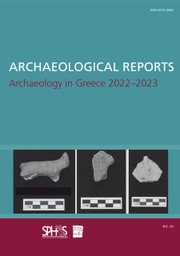Article contents
Recent research at the Sanctuary of Artemis Amarysia in Amarynthos (Euboea)
Published online by Cambridge University Press: 13 February 2018
Extract
The Sanctuary of Artemis Amarysia in Amarynthos was the most renowned shrine of the Eretrian polis, and its annual festival, the Artemisia, drew large crowds from Euboea and beyond. Yet, despite its regional fame and prominence, its remains have eluded archaeological identification. As a result, the location of the Artemision has been a vexed question in Euboean studies for over a century. Between 2003 and 2007, however, a new impetus was given to its localization. In collaboration with the Ephorate of Antiquities of Euboea, the Swiss School of Archaeology in Greece (ESAG) carried out a large-scale geophysical survey in the area of Amarynthos, some 11km east of Eretria, at the foot of a hill locally known as Paleoekklisies (or Paleochora). The ensuing trial trenches were followed by systematic excavation that eventually led to the discovery of substantial buildings. We suggest that these buildings are part of a monumental complex that should be identified as the Sanctuary of Artemis Amarysia (see afterword).
- Type
- Archaeology in Greece 2016–2017
- Information
- Copyright
- Copyright © Authors, the Society for the Promotion of Hellenic Studies and the British School at Athens 2017
- 3
- Cited by




